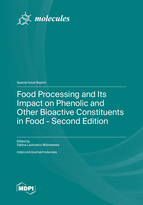Food Processing and Its Impact on Phenolic and Other Bioactive Constituents in Food – Second Edition
A special issue of Molecules (ISSN 1420-3049). This special issue belongs to the section "Natural Products Chemistry".
Deadline for manuscript submissions: closed (31 March 2023) | Viewed by 17789
Special Issue Editor
Interests: nutraceuticals and functional foods; medicinal plants; bioactive compounds; HPLC; LC-MS; nutrition; antioxidant agent; prebiotics; probiotics; symbiotics; bioavailability in vitro
Special Issues, Collections and Topics in MDPI journals
Special Issue Information
Dear Colleagues,
It is our pleasure to present this Special Issue of Molecules entitled “Food Processing and Its Impact on Phenolic and other Bioactive Constituents in Food—Second Edition”. Bioactive compounds including phenolic ingredients have long been used as important constituents of a healthy diet. As a result, consumer awareness about the important role of high-quality products rich in bioactive compounds—especially phenolic compounds—in human nutrition, health, and prevention against diseases has increased. Additionally, methods for food processing, regardless of the technology used, have a huge impact on the quality of the final products. Therefore, the big challenges for scientists lie in the monitoring of changes during food processing and the optimization of technology to achieve minimal degradation of nutrients (including phenolic compounds). Thus, for this Special Issue, I encourage you to publish your activities aimed at bringing the latest scientific news, insights, and advances in the field of food processing and its impact on bioactive constituents in food, especially phenolic compounds. The information presented will certainly attract considerable interest among a large group of our readers from different disciplines and research fields.
Dr. Sabina Lachowicz-Wiśniewska
Guest Editor
Manuscript Submission Information
Manuscripts should be submitted online at www.mdpi.com by registering and logging in to this website. Once you are registered, click here to go to the submission form. Manuscripts can be submitted until the deadline. All submissions that pass pre-check are peer-reviewed. Accepted papers will be published continuously in the journal (as soon as accepted) and will be listed together on the special issue website. Research articles, review articles as well as short communications are invited. For planned papers, a title and short abstract (about 100 words) can be sent to the Editorial Office for announcement on this website.
Submitted manuscripts should not have been published previously, nor be under consideration for publication elsewhere (except conference proceedings papers). All manuscripts are thoroughly refereed through a single-blind peer-review process. A guide for authors and other relevant information for submission of manuscripts is available on the Instructions for Authors page. Molecules is an international peer-reviewed open access semimonthly journal published by MDPI.
Please visit the Instructions for Authors page before submitting a manuscript. The Article Processing Charge (APC) for publication in this open access journal is 2700 CHF (Swiss Francs). Submitted papers should be well formatted and use good English. Authors may use MDPI's English editing service prior to publication or during author revisions.
Keywords
- polyphenolic compounds
- bioactive compounds
- food processing
- product quality
- natural products
- food safety
- phytochemicals
- carotenoids
- LC-MS/MS techniques
- HPLC-DAD-MS
- fruits and vegetables
- antioxidant compounds
- functional food







